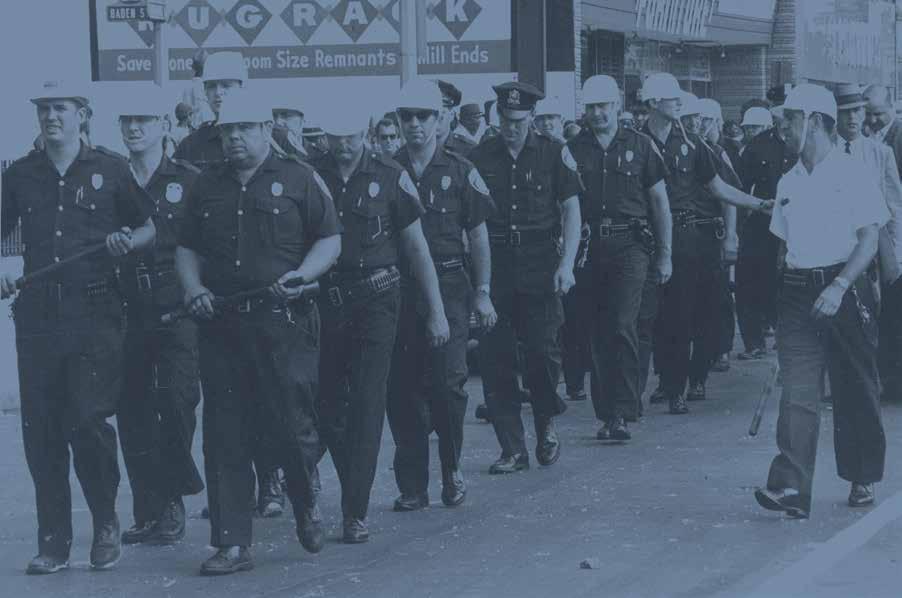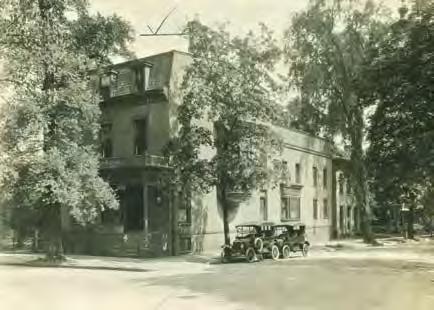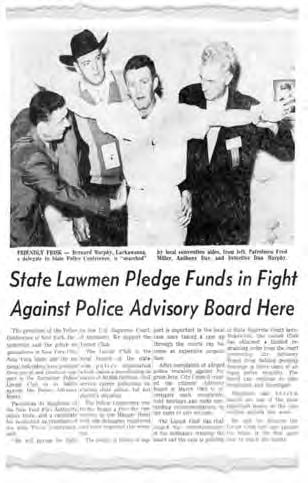
17 minute read
A COPPERS CLUBHOUSE
from March 2021
Rochester Police Department officers prepare to engage during the riots of 1964, the same year the Rochester Police Locust Club negotiated its first labor pact with the city.
PHOTO COURTESY THE CITY OF ROCHESTER
Advertisement
The evolution of the Locust Club:
From cop fraternity to roadblock to police reform
BY GINO FANELLI @GINOFANELLI GFANELLI@ROCHESTER-CITYNEWS.COM
Around the time that a Rochester police officer pulled out her pepper spray to use on a 9-year-old-girl, Mike Mazzeo, the president of the Rochester Police Locust Club union, pulled out a pen to sign a lawsuit contesting recent appointments by the police chief to the Rochester Police Department’s top brass.
Two days later, Mazzeo stood at a podium at the union’s headquarters on Lexington Avenue in blue jeans and a black sweater facing a firing squad of news reporters and stumbled through an explanation of the “psychological trauma” experienced by officers at the scene and blamed the girl’s mother for escalating the incident.
“It resulted in her, no injury to her,” Mazzeo said. “If they had to go and push further, and use more force, there’s a good chance she could’ve been hurt worse.”
His response to the incident, which thrust Rochester and its police onto the national news circuit for all the wrong reasons yet again, was widely ridiculed. Keith Olbermann, the itinerant liberal news and sports broadcaster, retweeted a video clip of Mazzeo at the news conference with the remark, “This idiot shouldn’t be sent to the grocery store to get a loaf of bread without a guide and four maps, let alone be a policeman in a large city anywhere in the world.”
How did it come to this? How does a union come to offer up a perspective so out of step with public opinion?
The answer for the Locust Club has been more than a century in the making. Since the organization transitioned from a social club for cops to the city’s recognized collective bargaining unit for police some 60 years ago now, the union has had a double-barreled primary charge: protect the rights of officers and defend those accused of misconduct.
The work has taken union representatives to court, to arbitration hearings, and to news conferences, where, like Mazzeo as of late, they can come off as defending the indefensible and twisting logic to its limits.
In the process, the Locust Club, like its union counterparts across the country, has emerged to many as an intractable roadblock to reform.
Mazzeo said a fair review of the Locust Club’s record over the last decade or so would show that the union has consistently pushed back against public safety initiatives “that have not been in the best interests of all in our community,” including decentralized police services and politicians’ tendency to parse crime statistics in a way that benefits their chances at re-election.
“I believe our most important function is to be the watchdog against bad public safety policy by city, county, and state governments,” Mazzeo said.
Five months before the girl was

pepper-sprayed, Mazzeo aggressively defended the officers involved in the death of Daniel Prude, arguing that they conducted themselves consistent with their training. Not only did the county medical examiner determine the officers suffocated Prude with their restraint holds, they did nothing to soothe Prude after he grew increasingly frantic. They never summoned mental health professionals, nor offered him a blanket or put him in a patrol car, even though he was naked on the road and the temperature hovered just above freezing.
Prior to Prude’s death becoming public, the Locust Club filed a lawsuit to hobble the creation of the Police Accountability Board, which city voters overwhelmingly approved by referendum. A state judge mostly sided with the union, although the litigation is ongoing. More recently, the union filed a lawsuit to delay the public disclosure of police disciplinary files.
Across the country, police are routinely shielded from public and departmental accountability by layer upon layer of contractual and legislative protections, most of which unions fought for over the decades.
“Everyone’s losing in this setup, in this void of accountability,” said Lee Adler, a professor of labor law and union leadership at Cornell University. “That void of accountability is created by two things: one is the training, and the way police are mandated to act, based on this training, and the second place we have to look, which may be more controversial, is how and why have police been assigned to do this work?”
A ‘COPPERS’ CLUBHOUSE
The Locust Club was born in the early morning hours of an April day in 1904.
Several officers met at the corner of South Avenue and Capron Street after a midnight tour of duty to discuss forming an organization to “promote the social, physical welfare and the material improvements of the members of the Rochester Police Department,” according to an annotated history of the union available in its online archives.
It was a bold move that split the rank-and-file by age, according to the history, with veteran officers wary of the idea and younger officers hungry to organize. Supporters were motivated by discontent among the ranks with pay, uniforms, and pensions — many of the same issues the union takes on today — and emboldened by having secured a picket line for striking coal drivers a month earlier.
Among the most pressing issues for officers of the day were new city ordinances that forbade detectives from holding office for a set tenure and required officers to wear their uniforms around the clock, even when they weren’t on duty.
Although police in New York City a dozen years earlier, in 1892, had formed what is now the largest police union in the country, the Police Benevolent Association, as a fraternal organization, no mid- to large-sized police department in the United States had an organization dedicated to addressing labor issues, according to the history.
The Locust Club claims to be the first police union in the country, although that’s debatable because the organization would not be a recognized bargaining unit for another nearly 60 years, long after the American Federation of Labor began chartering municipal police fraternal organizations as affiliates.
On April 17, 1904, the Rochester officers who spearheaded the effort, incorporated as the Locust Club, the name having been taken from the stiff and strong wood of the locust tree from which police batons were carved.
Like most police fraternal organizations of its time, the Locust Club had no formal relationship with the city, but its representatives informally bartered for better wages and working conditions. Four years later, it would join the New York State Patrolmen’s Association.
By 1921, the Locust Club was assuming a greater role in the social lives of officers. That year, the club bought a 22-room mansion on Spring Street built in 1830 by Thomas Hart Rochester, the son of Col. Nathaniel Rochester. Prominent residents of Rochester donated furniture — from a piano to game room equipment — and a who’s who of the city — from the mayor to judges to the district attorney — attended a celebration of the new clubhouse.
The mansion was a place where, according to the union’s history, members would “socialize freely” by playing cards, shooting pool, or unwinding with a drink. The club hosted “midnight shows” that featured movies, vaudeville acts, dancers, and comedians, and threw exclusive parties for cops, each of whom was allotted a single invite.
A 1939 thumb-sucker Democrat and Chronicle article headlined “Off duty with the officers,” referred to the Locust Club as having evolved into “purely a social organization,” and detailed the atmosphere inside what the author called the “coppers’” clubhouse.
“Meet them all together at a good party, however, with petit complaints and minor crimes alike forgotten as just part of the day’s job, and you’re in for a good time,” the article read, concluding with, “A grand place, a good gang and a lot of fun.”
FROM SOCIAL CLUB TO LABOR UNION
It was in the early 1960s that the Locust Club we know as a political power began to take shape.
For decades, the club had done nothing to address a lingering complaint among officers about their mandatory 56-hour work week and unpaid vacations.
That changed in 1962, when the AFL-CIO was formally recognized by the city, and the Locust Club began petitioning the city to be recognized as a police union. An early victory, one that helped legitimize its ability to organize and flex muscle, was the club successfully lobbying Albany for a 40hour work week that year.
The following year, the city recognized the Locust Club as the collective bargaining agent for police and the union began negotiating contracts for officers up to the rank of captain.
From there, the shift from a fraternity of “a good gang” of “coppers” to an aggressive bargaining unit unafraid to take on the city was swift. The union even sold its Spring Street clubhouse in 1964.
In the summer of that year, the first year that the Locust Club negotiated a labor pact, the union reportedly rejected the city’s contract offer for

This mansion at 111 Spring St. formerly served as the Locust Club's headquarters.
PHOTO PROVIDED

$250 annual raises over two years three times, becoming the only one of the city’s three public service unions to thumb its nose at the city.
The union eventually accepted a deal in August, after the race riots that upended the city, that would give officers raises of roughly $1,000 over two years, reportedly making Rochester police the ninth highestpaid in the country.
Emboldened by its success, the Locust Club turned its focus to the fledgling Police Advisory Board — a distant ancestor of today’s Police Accountability Board. Specifically, the union mounted a legal challenge to prevent the board from forming. The litigation failed, but bolstered the union’s image as a relentless defender of officers.
A few years later, in 1968, Locust Club brass took a shot at City Hall, when then-President Ralph Boryszewski alleged publicly that afterhours drinking and gambling hubs were protected by “the silent consent of public officials.”
Public Safety Commissioner Mark Tuohey and Police Chief William Lombard filed departmental charges against Boryszewski, at the urging of City Hall, accusing him of lying.
But in the ensuing weeks, the Locust Club drafted letters to President Lyndon Johnson and Gov. Nelson Rockefeller to enlist their help in getting the charges dropped, and the International Conference of Police Associations offered its support to the union and Boryszewski. After two days of deliberation, Tuohey exonerated Boryszewski.
Councilmember Andrew Celli lamented that the hearings were “a whitewash” and charged that the Department of Public Safety was improperly run. Boryszewski responded by saying Celli was unfit to hold office.
“Mr. Celli’s inflammatory remarks are hardly conducive to law and order,” Boryszewski wrote that year. “Councilmen don’t ordinarily play politics with the Police Bureau. The City Council should reprimand Celli.”
Notably, Celli’s son, also named Andrew, is the lawyer who is currently representing the City Council in its ongoing legal battle with the Locust Club over the union’s lawsuit seeking to strip the Police Accountability Board of key disciplinary powers.
In 1970, Rochester police officers went on a six-hour strike over wages, an action that violated the state’s Taylor Law and a pre-emptive order from state Supreme Court Justice Jacob Ark.
Yet, when it came to reopening contract negotiations between the union and the city, the union and its officers were granted amnesty.
Notably, again, Ark is the father of retired state Supreme Court Justice John Ark, who found in favor of the Locust Club in its case against the Police Accountability Board.
THE LABOR MOVEMENT AND DISCIPLINE
What many people don’t know about public service unions is that their leaders continue to be rank-and-file members of the agency they represent and get paid by taxpayers.
In the case of Mazzeo, he holds the rank of investigator with the Rochester Police Department, which pays him $151,200 a year in salary and benefits, according to the city budget.
Like other union leaders, though, he doesn’t do police work with any regularity. He is on what’s known in the police contract as “release time,” which frees him to spend nearly all his working hours on union business.
For that, he also receives a paycheck from the union. In 2018, the last year for which tax records were available, The Locust Club reported paying him an additional $28,600, financed by union dues, which total roughly $880,000 a year.
The double-dipping arrangement, however maddening it may be to adversaries of the union, is not unusual. In fact, there is court precedent that it is constitutionally mandated.
The union’s relentless defense of its members is also mandated by previous federal and state court decisions.
In the 1950s, the U.S. Supreme Court handed down a series of decisions in cases in which railway unions were charged with purposely not representing their Black employees. One June 1952 ruling stated that labor organizations designated as bargaining representatives have “a duty to represent in good faith all workers of the craft.”
Adler, the labor law and union leadership professor at Cornell, explained that based on the Supreme Court decisions, and subsequent decisions in state court, a union could decide against representing anyone in disciplinary matters, or to represent all members in such processes, but cannot pick and choose members to represent.
“Whether it’s whether white folks, or Black folks, or Hispanic folks who have seen members of their community harmed by the police, they often don’t understand why the police union should defend them at all, because they just see it as the officer did something wrong,” Adler said.
“But the police union looks at it as we have this responsibility to look at this,” Adler went on, “and as I have seen and heard so many times from police unions, they find the police officers are acting consistent with their training.”
This has been a common refrain from Mazzeo in high-profile cases of alleged misconduct. Indeed, for decades the Locust Club’s contract with the city has guaranteed that any member facing disciplinary charges would receive representation.
The Locust Club has also intervened on matters outside of the internal discipline process. When Officer Michael Leach fatally shot 18-year-old Denise Hawkins in 1975, the union filed a court order to block the release of Leach’s personnel files.
In December 1975, Locust Club attorney Pat Dinolfo, the father of state Supreme Court Justice Vincent Dinolfo, reportedly said the release of information around the Hawkins case would “dangerously hurt the ability of the police department to do its job.”
Following Hawkins’s death, the Locust Club accused the City Council of “interfering” with the Rochester Police Department for placing Leach on leave, pending an investigation. A grand jury was empaneled and Leach was exonerated. He went on to reach the rank of captain.
A CONTRACT GROWS AND GROWS
Employment terms for police officers are generally dictated by state civil service law. But collective bargaining agreements — union contracts — refine the protections and benefits for officers.
The Locust Club’s current contract with the city, for instance, includes provisions covering wage increases, paid leave, work schedules, uniforms, “release time,” and officer ranks.
But by far the longest and most detailed section of the agreement is that covering the discipline of officers accused of misconduct — and it has grown over time, as the city has agreed to concession after concession.
In 1974, the earliest year for which CITY could obtain a Locust Club contract, the provisions on officer discipline didn’t account for a full page. Today, they take up four pages.
The contract used to simply detail, in six straightforward provisions, how a disciplinary hearing would be carried out. The officer in question would be informed of the charge against him; a hearing would be scheduled; and the officer would have a representative of the union present and a lawyer, if he chooses. If the charge is sustained,

Rochester Police Locust Club President Mike Mazzeo. PHOTO BY MAX SCHULTE
the officer would receive a copy of the findings, and documentation would be added to the officer’s personnel file.
Those procedures still exist, but there are many more. Today, there are 23 provisions in the contract that guide officer disciplinary proceedings, and their rights in the process.
Hearings nowadays are to be held “at a reasonable hour, preferably when the member officer is on duty, and during the daylight hours,” and not more than 18 months after the alleged misconduct. For minor disciplinary matters, like letters of reprimand, the window is limited to 90 days from the alleged incident.
Both sides can call witnesses, and after the hearing panel has finished questioning the officer, the union representative or attorney can cross-examine.
The officer and their representative also have a say in who sits on the three-person hearing panel. Police brass are to provide the officer a list of three other officers, two of whom he can select to sit on the board. Then the officer submits a list of three superior officers, one of whom would be selected by the department. The chief has the final say.
The modern contract also has provisions that specifically protect the union. One prohibits the city and the department’s Professional Standards Section from asking the officer any questions regarding conversations between union members.
On top of all of these added-on rules and regulations is a provision allowing the Locust Club to complain to the chief in writing if it feels any of the protocols were violated. The chief would then take that complaint into consideration when deciding discipline.
Mazzeo himself has been the subject of misconduct investigations.
In May 1991, a 33-year-old Mazzeo was suspended with pay from his role as a vice squad officer in the Rochester Police Department’s Highway Interdiction Team, a rotating squadron of narcotics officers known as the HIT Squad. He was indicted on federal charges, alongside several other HIT officers. Among the accusations were that Mazzeo punched a man, used his gun to threaten someone, and stole overtime funds.
Mazzeo was found not guilty in 1993, and returned to active duty after a two-and-a-half-year suspension.
A RIFT IN THE LABOR MOVEMENT
Despite the at times outwardly bumbling public faces of the Locust Club, people on the ground working toward police reform generally acknowledge, if somewhat begrudgingly, that the Locust Club is skilled at achieving its purpose.
“You can look at their contracts, they’ve been very, very successful in creating a set of rules that determine how police officers are treated,” said Conor Dwyer Reynolds, the executive director of the Police Accountability Board. “Mike Mazzeo is very good at his job.”
Police unions have long been regarded with suspicion in labor circles for their tendency to view themselves as distinct from the labor movement. That suspicion has worsened with mounting instances of police violence and the police unions’ resistance to demands for reform.
In June, members of the Upstate New York chapter of Workers United called on the AFL-CIO to expel police unions from its ranks, in solidarity with the Black Lives Matter movement. The group cited a history of police unions not aligning with the values of workers’ rights. The AFLCIO resisted that call and similar pressure from other unions.
“We recognize that the fact that Black people are disproportionately working-class makes failing to be antiracist and supporting police unions an even greater betrayal of working-class struggle and unity,” a statement from the group read.
Mazzeo said expelling police unions is not the right answer.
“Attacking unionized workers while failing to hold policymakers responsible is wrong and why we have the problems that we are facing right now,” Mazzeo said.
Dan Maloney, the president of the Rochester Labor Council, said he supports both Mazzeo and the Locust Club as part of the broader labor movement. He echoed a frequent Mazzeo deflection — the problem isn’t the union, but rather the procedures and protocols put in place by the department, in which the union has little say.
Indeed, in the matter of the death of Prude, Mazzeo has vociferously defended the officers’ use of the “segmenting” maneuver to restrain him, arguing that the officers were trained to use the technique.
“You cannot blame our members for using what they are taught and are following procedures that they have no control over,” Mazzeo said. “I publicly stated that if that training is wrong and the procedures are wrong, change them.”
Segmenting is meant to be a quick and effective way to subdue a noncompliant person, and is taught to officers in most every police department in New York as part of a statewide police curriculum. But Prude was already in handcuffs and immobilized when officers applied the technique.
“Mike administers the contract for the cops in the city of Rochester, but he does not have much say in anything over the hirings and firings, and doesn’t have much say over training and protocol,” Maloney said. “He’s been screaming for change.”








